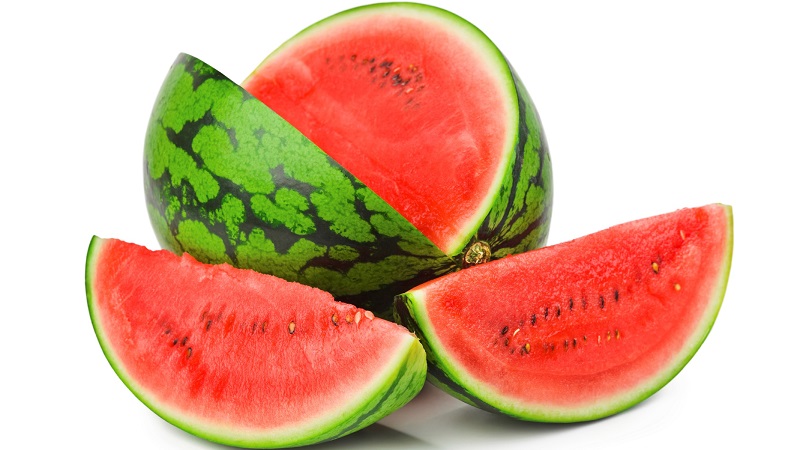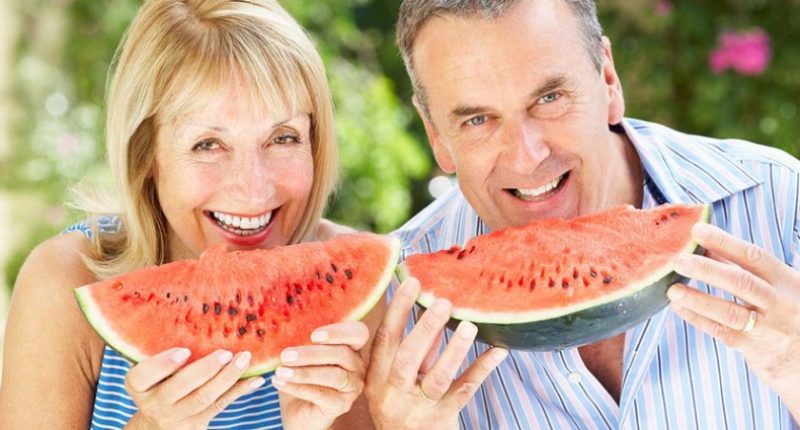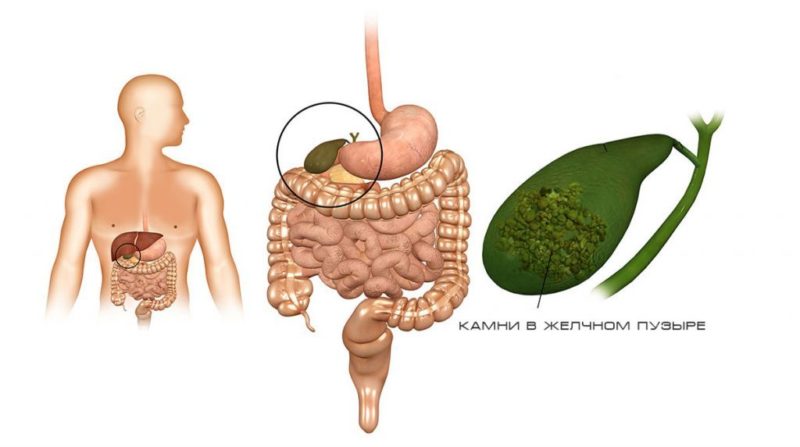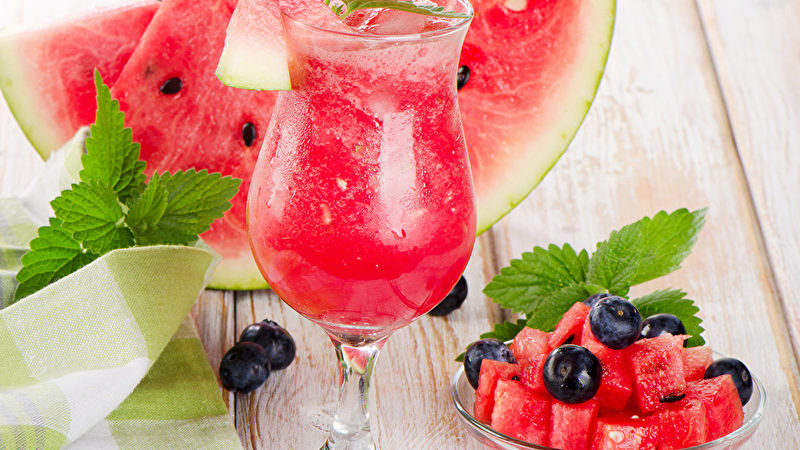Watermelon with stones in the gallbladder: is it possible to eat and in what quantities
The choleretic properties of watermelon are a well-known fact, and the benefits of using this berry for cholecystitis are beyond doubt. However, the product has a number of contraindications that must be taken into account in order not to cause even more harm to the body. Is it possible to eat watermelon with stones in the gallbladder, we will tell in the article.
The content of the article
Chemical composition and calorie content of the product

In 100 g of the edible part of the watermelon, 26.9 kcal.
The chemical composition is presented in the table:
|
Essential nutrients |
Vitamins | Macronutrients | |||
| Name | Quantity, g | Name | Quantity, mg | Name | Quantity, mg |
| Protein | 0,59 |
RR, NE |
0,29 | Potassium | 109 |
| Fats | 0,19 | IN 1 | 0,04 |
Calcium |
13,9 |
| Carbohydrates | 7,59 | AT 2 | 0,06 |
Sodium |
15,9 |
| Cellulose | 0,41 |
AT 4 |
4 |
Chlorine |
24,8 |
| Water | 91,5 |
AT 5 |
0,22 |
Magnesium |
11,9 |
|
Ash |
0,3 |
AT 6 |
0,1 |
Silicon |
12,1 |
|
Organic acids |
0,09 |
AT 9 |
0,01 |
Phosphorus |
6,9 |
|
Alimentary fiber |
0,39 |
E, TE |
0,09 |
Sulfur |
0,62 |
|
Essential amino acids |
0,2 |
Beta carotene |
0,11 | Trace elements | |
|
Essential amino acids |
0,06 |
Niacin |
0,19 | Iron | 0,99 |
|
Polyunsaturated fatty acids: |
AND |
0,16 | Manganese | 0,04 | |
|
Omega-3 |
0,02 |
FROM |
6,9 | Copper | 0,04 |
|
Omega-6 |
0,05 |
TO |
0.1 μg |
Cobalt |
0,01 |
|
Saturated fatty acids |
0,02 |
Aluminum |
0,29 | ||
|
Zinc |
0,1 | ||||
Benefits for the gallbladder
The formation of stones that clog the ducts of the liver and gallbladder is associated with a violation of the outflow of bile. This is due to the fact that the secretion, synthesized by liver cells and containing salts, bilirubin and cholesterol, begins to thicken. Incorrect metabolism in the body is one of the causes of the development of the disease.
Reference. When drinking watermelon, the outflow of bile improves, existing stones are removed, and the formation of new ones slows down.
As a natural diuretic with a diuretic effect, watermelon accelerates the formation of urine and removes excess fluid from the tissues, which contributes to:
- removal of edema caused by stagnation of bile, and normalization of pressure;
- preservation of cells, vascular walls and capillaries from destruction;
- elimination of toxins and toxins from the body.
Vitamins of group B, as well as A and E, help fight disease by promoting:
- acceleration of metabolic processes in the body;
- normalization of water-salt balance;
- break down fats and protect the liver from their effects;
- increasing the elasticity of the walls of the gallbladder and strengthening them;
- restoration of liver cells;
- improving blood circulation and hematopoietic processes;
- general strengthening of the body, increasing its protective properties.
Vitamin C, macro- and microelements strengthen the walls of blood vessels.
Antioxidants have a protective effect on cells and membranes.
Carbohydrates (fructose and glucose) nourish the liver tissue and contribute to its normal function.

Read also:
Is it possible to eat watermelon with gallstone disease
Signs that bile flow is impaired due to the presence of sand or stones:
- decreased appetite;
- nausea and frequent belching;
- pain in the right hypochondrium;
- bitterness in the mouth.
Due to the choleretic properties of the product, it is possible to use the berry with stones in the gallbladder, but there are exceptions:
- too large a calculus;
- the presence of concomitant pathologies and other diseases in which watermelon is contraindicated.
With sand and small stones
Consisting of more than 90% water, watermelon liquefies thickened bile, and the diuretic effect of the product promotes the expansion of blood vessels and bile ducts clogged with stones.
As a result of this effect, grains of sand and small stones (no more than a few millimeters in diameter), together with liquid secretions, are released naturally through the intestines.
For large stones in the gallbladder

If there are large stones in the gallbladder, it is not just undesirable to use any products and drugs that have a diuretic effect, but it is dangerous.
Attention! In the presence of large stones, drinking watermelon can lead to inflammation, pain and even rupture of the ducts.
Getting rid of large stones is possible only through surgery, and drinking watermelon will only aggravate the situation.
For stones with concomitant pathologies
The presence of stones in the gallbladder can cause concomitant pathologies:
- biliary pancreatitis, resulting from the ingress of bile into the pancreatic duct;
- cholecystitis - inflammation of the gallbladder;
- cholangitis is an infectious inflammation of the bile ducts.
Due to the content of a large amount of dietary fiber in the composition of watermelon, not processed by enzymes, a high concentration of carbohydrates and choleretic properties of the product, which enhance the secretion of pancreatic juice, the use of berries creates an additional load on the pancreas.
Important! Eating a watermelon with biliary pancreatitis is undesirable, and with an exacerbation of the disease, it is strictly prohibited.
For cholecystitis and cholangitis, the use of watermelon, which improves the outflow of bile, is recommended during remission in small quantities.
In the case of chronic cholecystitis, it is useful to arrange a fasting day once a week, eating 1.5 kg of pulp in 6 doses.
In folk medicine, for pathologies of the biliary system, to improve the outflow of bile, prevent its stagnation, relieve inflammation and dissolve small stones, drugs are used prepared on the basis of:
- watermelon peel;
- seeds;
- juice.
The measure of the use of watermelon for gallstone disease
How much watermelon can you eat with LCD:
- If the disease is limited by the presence of sand, it is recommended to consume 0.5 kg of berries during the day, dividing the serving into 2 doses.
- For small stones - 200 g of the product 1-2 times a week.
Features of use
In order for the use of watermelon with stones in the gallbladder to bring only benefits, you need to follow a few simple recommendations:
- Do not use the product instead of other food or water, or in the morning on an empty stomach.
- Introduce the fetus into the diet, starting with one lobule and gradually increasing the amount consumed to the permitted rate.
- Use the product as a snack between meals and do not drink it with water or other liquid.
- There is a berry in moderation, adhering to the norms proposed by experts.
- Do not eat the watermelon too cold, as this will compress the gallbladder and cause pain.
- There are only fruits that have ripened naturally, acquiring them from the second half of August to mid-October.
- If you feel worse, exclude the product from the diet.
With gallstone disease, not only watermelon pulp is beneficial, but also seeds and especially the peel due to the high content of vitamins and minerals in it.
Read also:
How to use watermelon for cystitis: how much you can eat during the day
Watermelon compatibility with milk and other products
What is the glycemic index of watermelon, and what nutritionists think about it
Healthy recipes

Salad with fresh vegetables and cheese:
- Cut into small pieces 1 cucumber, 1 bell pepper, 3 tomatoes and 300 g of watermelon pulp.
- Add 200 g of chopped feta cheese.
- Salt, season with sunflower oil (2-3 tbsp. L.) And mix.
Curd dessert:
- Cut 300 g of watermelon pulp into cubes.
- Add 200 g of low-fat cottage cheese.
- Mix everything with a little honey.
Fruit and berry cocktail:
- Use a blender to chop the watermelon pulp.
- Add banana, strawberries or other fruits that are not allergic.

The peel is cut into pieces and dried in the oven, after which it is poured with water in a ratio of 1: 1 and simmered over low heat for 30 minutes. The broth cooled to room temperature is taken in 200 ml 3 times a day before meals.
The seeds are dried, purified water with a small amount of honey or sugar syrup or milk is added to them and infused for 7 hours, stirring occasionally. Drink the infusion before meals for half a glass.
Important! Before you start using watermelon-based folk remedies for cholelithiasis, you should definitely consult your doctor.
Possible harm and contraindications
If the product is misused, the body can be harmed:
- active movement of stones leads to blockage of the bile ducts;
- a sharp contraction of the gallbladder causes frustration and pain.
During the period of exacerbation of the disease, the product should also be excluded from the diet, resuming use no earlier than 7-20 days after the disappearance of pain.
The berry is contraindicated to be eaten at:
- exacerbation of pancreatitis, cholecystitis, gastritis;
- colitis;
- the presence of large stones;
- pyelonephritis;
- kidney stones;
- exacerbation of prostatitis (inflammation of the prostate gland).
The negative effect of the berry on the body of a person suffering from cholelithiasis is possible in the presence of diabetes mellitus and obesity.
Attention! Watermelon is not recommended for children under 2 years of age.
Overeating increases the risk of allergic reactions and diarrhea.
Conclusion
A careful approach to the choice of food will help in the fight against any disease, including gallstone. In the absence of large stones in the gallbladder and other contraindications to the use of watermelon, eating this tasty, juicy berry in moderation, as well as medicinal decoctions and infusions on seeds and crusts, will significantly benefit the patient's body.